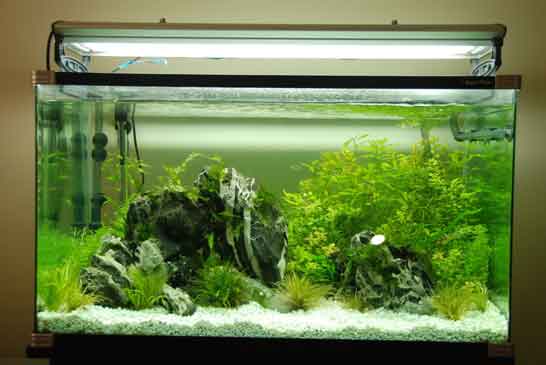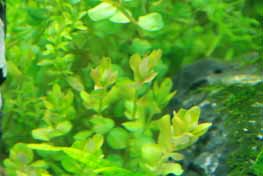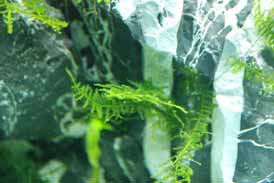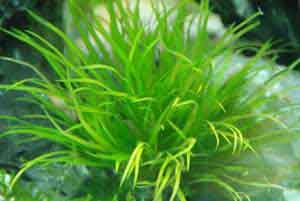
Planting Your Aquarium
HOW TO PLANT YOUR AQUARIUM?
Planting the aquarium is an important part of a planted aquarium. Before planting can begin a small amount of planning can go a long way. A few hours spent planning making sure that you know where each plant is going to go and what your expectations are after a few months of growth will save hours of headache.

During this planning stage factor in the addition of interesting rocks and driftwood which can give your aquarium a very natural tone. Consistent use of one type of rock or driftwood in the tank yields the most aesthetically pleasing results. Plan with foresight and structure your hardscape to suit an aquarium with a few months of growth.
If you have bought your plants and the tank is ready, it’s time to plant! This is an important part which will take some time and could be frustrating, make sure you give yourself at least a few hours uninterrupted.

Stem Plants

- When bought these usually come with elastic or wire around the base holding the stems together. Carefully remove this wire to separate each of the stems. You could plant stem plants densely all in one bunch but it gives a nicer feel if they are spread out along the background. At first you probably won't have enough stems to fill the background layer.
- This is not a concern as the stems will soon grow and you will be able to propagate the tops in no time. Having taller stems in each of the corners and then shorter ones in the centre will give the aquarium a mountainous shape. In this manner the plants will also hide the heater and filter lines. These stems should be pushed about an inch or two into the substrate. Soon they will grow a strong root system and they will grow noticebly faster!

Anubais and Java Fern

- These types of plants will need to be attached to the wood or submerged rocks within the aquarium as this is how they exist and grow in nature. Often times you may be able to wedge ferns and anubais between rocks and hardscape to prevent them from floating away. When plants are needed in specific areas they will often need to be tied on.
- Fishing wire is an option to tie plants onto hardscape and is virtually invisible once the plant begins to grow. However it can sometimes restrict the plants growth and will not dissolve in the aquarium water. Cotton thread is a more appropriate choice as it will eventually dissolve in the water column. It is harder to tie the plants to the hardscape and it not suitable for larger plants but once dissolved the plant will be well adhered to the rock.

Crypts/potted plants
- Crypts and potted plants will generally come in small plastic or clay pots with cotton wool to protect the root structure and provide an intermittent substrate.
- To plant potted aquatic plants like these, take out the wool and carefully remove the plant from the pot making sure to be extra careful with the root system.
- Although potted plants can be placed directly into the substrate with the pot, this is not recommended and will limit the plants growth. The easiest way to plant crypts and other potted plants is dig a small hole in the gravel, push the plant into it and cover it up on all sides after removing from the pot.

Moss

- Moss will look its best when it is placed on wood, rocks and other hardscape. It is a beautiful addition to the aquarium due to its light feathery texture that will sway with the aquariums natural currents. It is a fast growing plant especially in open areas and close to the surface.
- Moss can be grown just about anywhere in the planted aquarium but looks best with a dark contrast background such as black rock or darker driftwood. To attach moss such as Christmas Moss, Java Moss, Peacock Moss or Flame Moss (just to name a few of the more popular types) a similar method is used to planting anubais and java ferns.
- Planting moss can be an extremely frustrating process due to moss size and density. Switching off the filter is an excellent idea and will make the planting go much more smoothly. The easiest method for planting is to tie on the moss with fine colourless cotton string.
- This can be made even easier by removing relevant hardscape pieces and doing this process outside of the aquarium. Another excellent method of planting that avoids the use of tying fine thread involves coins. In this method by using an inert coin it can be placed directly onto the moss to weigh it down. After some time, usually within a week, the coin can be removed from the aquarium and the moss 'feet' will have grown onto the ornament.

Hair grass

- Hair Grass usually can be bought in small pots with tens of stems. It is relatively cheap for a substrate plant and can be grown in lower light conditions. As the name suggests, it has a unique property of being able to grow along the bottom of the aquarium in a similar fashion to grass on land. When planting hairgrass it is important to carefully remove the stems from the pot with minimal handling of the roots.
- At this stage it is possible to spread out each shoot into one or two stems. From here plant each thin stem about half an inch from the next in a grid pattern. There are a number of advantages to this. Hairgrass will spread naturally and densely. Planting with foresight will save money and allow easy monitoring of the hairgrass.Ultimately within a few months you will be left with a grass floor of the aquarium.
Brief Tips
- Remember to make use of a strong aquarium light, co2 and fertilizers. This is especially important in the initital stages after planting. The plants have been depleted and begin to grow back their rooting system within their new aquarium.
- When purchasing aquatic plants look for healthy, budding plants that show signs of white roots. Look carefully in the display tank for any signs of algae. Most algae reproduce by spores and are invisible to the eye, even if the plant looks healthy you can still be introducing foreign spores.
- Always research plants before buying them. Many unreputable LFS sell aquatic plants such as the aluminium plant that is unsuitable for long term culture in an aquarium.
- Rarer, easy to care for or unusual mosses are usually unavailable at most LFS. Online forums provide an excellent way to purchase plants from reputable growers and high quality aquarists.
Congratulations! After the initial planting process you have a barebones planted aquarium that will soon grow and mature. Be sure to read this article on trimming and maitenance to properly maintain your aquarium as it goes through the different stages of development.
For a more challenging but rewarding topic continue to a guide on aquascaping that explores integrating the principles of design and nature into your aquarium.






